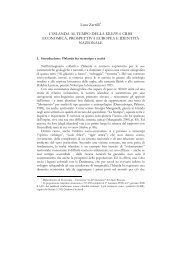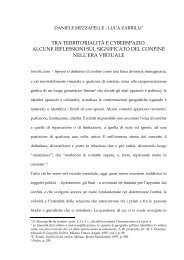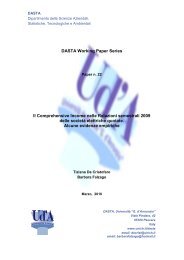DASTA Working Paper Series Life Cycle Assessment in the tourism ...
DASTA Working Paper Series Life Cycle Assessment in the tourism ...
DASTA Working Paper Series Life Cycle Assessment in the tourism ...
You also want an ePaper? Increase the reach of your titles
YUMPU automatically turns print PDFs into web optimized ePapers that Google loves.
<strong>DASTA</strong> – <strong>Work<strong>in</strong>g</strong> <strong>Paper</strong><br />
Special features Besides <strong>the</strong> already mentioned benefits (see section 3.9)<br />
<strong>in</strong> us<strong>in</strong>g more than one impact assessment method, this case study confirmed,<br />
as Chambers‟ experience also did (see section 3.4), that LCA can also be<br />
implemented to package holidays. A scenario analysis has been implemented<br />
to compare different transport modes which can be chosen by tourists.<br />
Ma<strong>in</strong> limitations Because <strong>tourism</strong> is a complicated system, <strong>the</strong> author of<br />
this case study faced significant difficulties <strong>in</strong> outl<strong>in</strong><strong>in</strong>g functional unit and<br />
system boundaries.<br />
4 Discussion<br />
A critical analysis of <strong>the</strong> literature revealed considerable dissimilarity as<br />
regards <strong>the</strong> methodology application: from <strong>the</strong> choice of <strong>the</strong> specific<br />
<strong>in</strong>strument – conventional LCA, IO LCA, etc. – to <strong>the</strong> def<strong>in</strong>ition of objectives,<br />
<strong>the</strong> study object and o<strong>the</strong>r methodological choices.<br />
The objectives of <strong>the</strong> study are a critical factor for <strong>the</strong> choice of <strong>the</strong> specific<br />
<strong>in</strong>strument to be adopted and <strong>the</strong> related methodological approaches. If IO<br />
LCA may be used to assess, compare and steer environmental policies for<br />
<strong>tourism</strong>, conventional LCA may be used by a wide range of stakeholders and<br />
for different purposes. For example, specific <strong>tourism</strong> organizations and tour<br />
operators would ma<strong>in</strong>ly use LCA to: assess environmental performance to<br />
identify hot spots; support <strong>the</strong> improvement of environmental performance<br />
through <strong>the</strong> comparison of <strong>in</strong>novative environmental technologies, compare<br />
<strong>the</strong> environmental performance of tourist products; support eco-design<br />
choices, and support green market<strong>in</strong>g.<br />
On <strong>the</strong> o<strong>the</strong>r hand, governmental organisations might use <strong>the</strong> tool to:<br />
assess <strong>the</strong> environmental performances of a tourist dest<strong>in</strong>ation to identify hot<br />
spots; support <strong>the</strong> draw<strong>in</strong>g-up of local market<strong>in</strong>g plans for <strong>tourism</strong>; assess <strong>the</strong><br />
environmental weight of each different form of <strong>tourism</strong> developed <strong>in</strong> <strong>the</strong> area;<br />
compare mobility plans for an environmental viewpo<strong>in</strong>t; environmentally<br />
compare waste management scenarios <strong>in</strong> order to def<strong>in</strong>e a local management<br />
plan for wastes; assess, plan and forecast environmental impact scenarios if<br />
<strong>in</strong>tegrated with Strategic Environmental <strong>Assessment</strong> (SEA), Environmental<br />
Impact <strong>Assessment</strong> (EIA) and even with Geographic Information System<br />
(GIS); support <strong>the</strong> Green Public Procurement; support <strong>the</strong> implementation of<br />
Environmental Management Systems, such as ISO 14001:2004 and EMAS.<br />
F<strong>in</strong>ally, NGOs might use LCA to support <strong>the</strong>ir environmental campaigns.<br />
Ano<strong>the</strong>r critical aspect <strong>in</strong> <strong>tourism</strong> LCA studies is <strong>the</strong> def<strong>in</strong>ition of <strong>the</strong> system<br />
boundaries. This issue may profoundly affect subsequent LCA phases –<br />
<strong>in</strong>ventory analysis (LCI) and environmental impact assessment (LCIA) –<br />
provid<strong>in</strong>g different result <strong>in</strong>terpretations.<br />
The choice of <strong>the</strong> environmental impact assessment method, f<strong>in</strong>ally, is very<br />
important because tourists are particularly sensitive to local environmental<br />
issues – such as, for example, noise pollution, hydro-geological disruption,<br />
and smell pollution – which are seldom considered <strong>in</strong> current LCIA methods.<br />
F<strong>in</strong>ally, <strong>the</strong> low number of studies found <strong>in</strong> <strong>the</strong> literature might <strong>in</strong>dicate<br />
significant obstacles <strong>in</strong> adopt<strong>in</strong>g this approach or <strong>tourism</strong>'s drivers' limited<br />
awareness of LCA. Obstacles may <strong>in</strong>clude: complexity of <strong>the</strong> <strong>tourism</strong> system;<br />
implementation time be<strong>in</strong>g too long because of a lack of specific LCA<br />
De Camillis, Raggi, Petti 14






